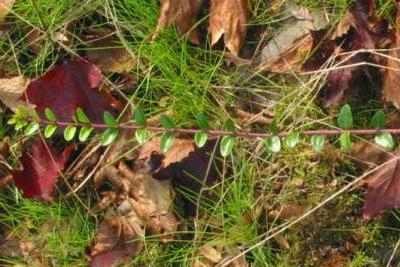Lonicera nitida Wils. (syn.: L. pileata Oliver var. yunnanensis (Franch.) Schulz, L. ligustrina Wall. var. yunnanensis Franch.) (China) – A much increasing and common escape from cultivation, usually very persistent and probably becoming naturalised locally. First recorded from old walls and urban wasteland in Gent in 2000 but by now known from numerous very widely scattered locations throughout Belgium (but perhaps more so in Flanders). Lonicera nitida is most often found on walls, wasteland, cemeteries and increasingly also in woodland or parks (foot of trees, under shrubs, … obviously birdsown).
Lonicera nitida much looks like L. pileata and both are often confused. There is a copious literature on their distinction (see below). Lonicera nitida usually grows taller and has much smaller leaves (see key). A form of the latter (cv Elegant, syn.: Lonicera yunnanensis Hort. non Franch.) is intermediate between L. nitida and L. pileata and juvenile plants are probably indistinguishable (Loos 1997). Therefore, Schulz (2011) proposed to subsume Lonicera nitida as a variety under L. pileata and provides an interesting discussion on these taxa. Alternatively, and perhaps even more convincing, both L. nitida and L. pileata have been considered very closely related to L. ligustrina and are probably best considered mere varieties of the latter (see Yang 2011 in Fl. China). The ease with which L. nitida and L. pileata seem to hybridize (Wilcox 2016) also suggests a close relationship. See also Armitage & Costain (2017) for a thorough discussion.
Non-flowering plants of this and the following species superficially look like Cotoneaster and both genera often grow in similar places. However, leaves in Lonicera are opposite while they are alternate in Cotoneaster.

Selected literature
Adolphi K. (1995) Neophytische Kultur- und Anbaupflanzen als Kulturflüchtlinge des Rheinlandes. Nardus 2: 272 p.
Armitage J. & Costain K. (2017) Name changes for Lonicera nitida and L. pileata. Plantsman N.S. 16(4): 232-235.
Clement E.J. (2003) More about Lonicera nitida. BSBI News 94: 34-35.
Clement E.J. (1984) Lonicera spp in Great Britain and Ireland. BSBI News 37: 22-23.
Crawley M.J. (2004) Distinguishing Lonicera nitida and L. pileata. BSBI News 95: 48.
Loos G.H. (1997) Neophytische Kulturflüchtlinge im Stadtzentrum von Kamen/Westfalen. Decheniana 150: 5-26.
Schmid M. (2005) Untersuchung zur neophytischen Gehölzflora im Stuttgarter Stadtgebiet. Jh. Ges. Naturkde. Württemberg 161: 178-257.
Schneider F. (1971) Lonicera pileata en L. nitida. Dendroflora 8: 42-45.
Schulz B. (2011) Die Immergrüne Heckenkirsche Lonicera pileata Oliver 1887 (Caprifoliaceae) und ihre Varietäten (var. pileata und var. yunnanensis stat. nov.). Mitt. Deutsch. Dendrol. Ges. 96: 93-98.
Verloove F. (2002) Ingeburgerde plantensoorten in Vlaanderen. Mededeling van het Instituut voor Natuurbehoud n° 20: 227 p.
Wilcox M. (2016) Lonicera nitida (Wilson's honeysuckle) and L. pileata (box-leaved honeysuckle). BSBI News 132: 34-38.
Yang Q., Landrein S., Osborne J. & Borosova R. (2011) Caprifoliaceae. In: Flora of China Editorial Committee (ed.), Flora of China, vol. 19. Science Press, Beijing & Missouri Botanical Garden Press, St. Louis: 616-641. [available online at: http://flora.huh.harvard.edu/china/mss/volume19/Flora_of_China_Volume_19...
Yeo P.F. (1964) Lonicera pileata and L. nitida in cultivation. Baileya 12: 56-66.

